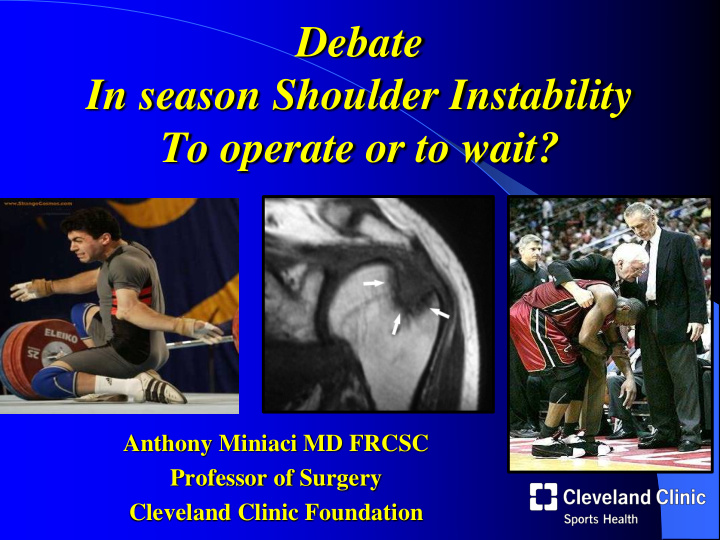



Debate In season Shoulder Instability To operate or to wait? Anthony Miniaci MD FRCSC Professor of Surgery Cleveland Clinic Foundation
Conflicts of Interest 1. Royalties/stock/equity 3. Educational/Research 1. Arthrosurface Institutional 1. Stryker 2. Arthrex 3. Arthrosurface 2. Consulting/Honoraria 1.Stryker 2. Arthrosurface 3. Arthrex 4. Smith and Nephew
Debate Instructions per Kevin Plancher 1. Tell why you wait till seasons end for shoulder instability surgery 2. Tell why it is better than operating on everyone during the season 3. I don’t care if that is what you do or not !
Primary Question- Debate-Can they RTP? In-Season Athlete RTP 1. NOT-What is the risk of recurrence? 2. Can an in-season athlete return to sport? 3. What is the harm in waiting? 1. does it change the treatment or result 2. What is the psychological or physical harm 4. Which dislocator needs to be fixed immediately?
Lets not argue- # 1) Risk of recurrence? We know the risk is high Author Recurrence rate especially in contact sports and Wheeler Arthroscopy 1989 82% young patients Rates vary 27-82% for first time Arciero AJSM. 1994 80% dislocators Jakobsen 1994 27% Age<20, contact sport Pathology 80% Bankart, 15% Bottoni AJSM. 2000 75% bony Bankart, 70 % Hill Sachs Sachs JBJS. 2007 46% lesion LeClere Sport Health. 2013 52% Most will need surgery –BUT not all ! Kirkley et al Arthroscopy 47% 1999 Do they need it now or can they have another shot at it?
Can they get back to play? Mean Time to Return to Play 7 Days Distribution by Sport Return to Sport Fail Return to Sport Lacrosse Boxing Judo 2% 4% Separated 6% 8% Baseball 4% End of Season Wrestling 33% 7% Failed Return to Rugby Return to 11% Sport Sport Football Insuffienct 75% 25% 66% Function 59% 75% Return to Play Return to play and recurrent instability after in-season anterior shoulder instability: a prospective multicenter study. Dickens JF et al . AJSM 2014
Return to Sport Subluxation Dislocation • Median RTP 3 • Median RTP 7 Subluxation days 42% days Dislocation 58% • 76% completed • 56% completed the season the Season p=0.282 Subluxation 5.3x more likely to return to sport compared to dislocations (95%CI 1.00. 28.07; p=0.049)
Debate-Return to Sport after Shoulder Instability 30 patients, contact and noncontact sports Mean 16 years old 90% return to sport Subjective: all athletes at “same or near same level” Mean time lost from sport: 10 days
Return to play 30 patients,19 dislocations, 11 subluxations 26/30 returned to their sport for the complete season with an average missed time of 10.2 days 37% experienced an additional episode 16 had off season surgery “ no further injuries attributable to the shoulder instability”
Will the real Michael Freehill please stand up !
What happens when they do return to play? Dickens JF Am J Sports Med.2017 Sep;45(11):2540-2546 10 electing nonoperative Successful Return to Sport After Arthroscopic Shoulder treatment, 4 (40%) successful RTP Stabilization Versus without recurrence during the Nonoperative Management in subsequent season Contact Athletes With Anterior 29 surgical, 26 (90%) RTP without Shoulder Instability: A recurrence the following season Prospective Multicenter Study. No long term differences as to 39 with another season of eligibility timing 10 chose rehab , no surgery Does waiting hurt? 20 chose surgery after season Does it give you more pathology 9 chose immediate surgery or change the operation after one event
Does waiting Hurt? Acute vs Chronic • 127 patients; diagnostic arthroscopy, x-rays (AP, Glenoid, West Point), MRI Arthroscopy 2007
But are 2 episodes really chronic? 29/39 athletes surgical stabilization there was no difference in RTP between the 9 I think not ! stabilized after a single Successful Return to Sport After instability event (90% RTP Arthroscopic Shoulder rate) and the 20 stabilized Stabilization Versus after multiple in-season Nonoperative Management in Contact Athletes With Anterior recurrent instability events Shoulder Instability: A (89% RTP rate). Prospective Multicenter Study. Dickens JF Am J Sports Med.2017 Sep;45(11):2540-2546
Does it change the surgery? Probably not ! Patients are already high risk because of age/competition/contact sport All hinges on the BONE LOSS Need to think about this when you assess the patient Debate may be about type of surgery not timing Balg & Boileau, JBJS-Br, ‘07
Psychologic effects of not playing Mind, Body and Sport: How 1. Sadness being injured affects mental 2. Isolation health 3. Irritation An excerpt from the Sport Science 4. Lack of motivation Institute’s guide to understanding and supporting student-athlete 5. Anger mental wellness 6. Frustration The team physician is ultimately 7. Changes in appetite responsible for the return-to-play decision, and addressing 8. Sleep disturbance psychological issues is a significant 9. Disengagement component of this decision. By Margot Putukian
Importance of Team Play They are only young once! 1. Builds confidence 2. Provides consistent exercise 3. Develops relationships. 4. Contributes to stronger academics. 5. Helps put winning into perspective. 6. Teaches respect. 7. Encourages family involvement. 8. Chance to win as a team- very unique once in a lifetime opportunities Dr. Freehill wants to take that away from them !!
Summary- My position! Based on the Evidence RTP is possible after a first time shoulder instability in season episode 75 % RTP in 7-10 days for dislocation 3-5 subluxation 40 % may have a second in season injury Up to 40 % may not have anything even after 2 seasons 2 events and out Remember to assess for bone loss Remember you are treating the athlete and not just their shoulder- avoid shattering dreams!
Anthony Miniaci M.D. FRCSC Professor of Surgery Cleveland Clinic
Recommend
More recommend